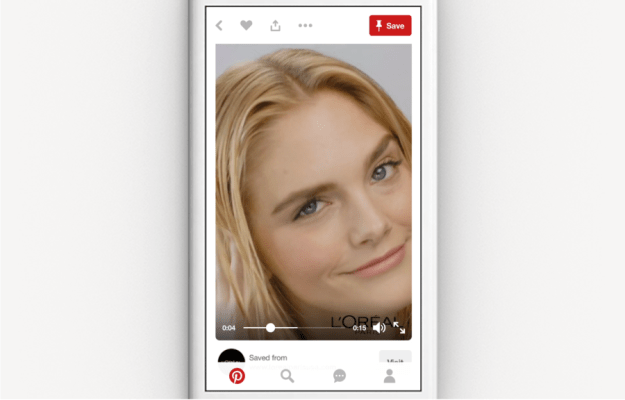Pinterest is adding another ad to its array of products, now allowing advertisers to publish video advertising that will automatically play in the home feed and search, as it continues to bulk up and woo advertisers with a different pitch from Facebook and Google.
Pinterest has had to make the argument to advertisers that its 175 million users behave differently on Pinterest when compared to Facebook and Google, or even Twitter and Snap. Pinterest users come to the site and dig through products and recipes, among other things, for ideas. They then search deeper into topics, save them, and then eventually in theory acting on them later — either by cooking the dish or buying a product. Pinterest’s pitch is that unlike Facebook and Google, which can offer a compelling ad product for one point of that part of a customer’s buying life, it can offer products across the whole timeline.
The ability to catch those possible customers early on and follow them all the way to the final buying process is something that might entice advertisers, but it still has to ensure it has the advertising products to back it up. Today’s announcement, which opens up autoplay video ads to all partners, gives it yet another argument that it can offer something competitive to Facebook — which has shown that video can have greater engagement and offers a potentially lucrative new source of customers.
“The main difference we notice is that some users watch more content direct in their feed,” Pinterest product lead Mike Bidgoli said. “Previously they’d see the preview, and now they’ll take that action. In general, video is a little higher up the funnel [generating brand awareness] activity. We’re trying to bend the curve between that discovery to [taking an action] on our platform.”
Pinterest may indeed have an additional edge in its pitch given that Facebook has had some problems in reporting its numbers. As newer ad products emerge it’s critical to build up that trust with advertisers in addition to showing that the ads can be effective. Pinterest is partnering with Nielsen and Moat to give its advertisers accurate measurements on their ads and the results that they can deliver. That’s going to be important as Pinterest tries to show advertisers that it can tap into multiple different kinds of user behavior on its service, like search.
“That’s a place where people have a lot of intent [to act],” Bidgoli said. “We think we have a shot bringing people both to top of funnel as well as bottom. That would allow us to play with some performance advertisers. They can pair a video with a set of pins that they want Pinner to take action on. That’s still a big part of it. The “do” component, people are on Pinterest to get inspired and then they do that.”
In general, autoplay is the direction that mobile video is headed as a default — and that will extend to advertisers as well. There’s the question around data consumption, but Bidgoli said even though the company obsessed about it initially but found through testing that it “wouldn’t rip any alarms.” Users will still have the option to turn autoplay off in settings if they see fit.
Video offers a new kind of engaging content that users can find when casually browsing around the app, but beyond that Pinterest is trying to diversify its range of products to tie the experience of Pinterest closer and closer to the real world. That might look like its Lens product, which allows a user to point their camera at a product to execute a search, to watching a video for how to cook a dish. But either way, the sum of all these products is an advertising pitch that is an effort to move the company away from those experimental advertisement budgets to a mainstay ad purchase with bigger brands.
